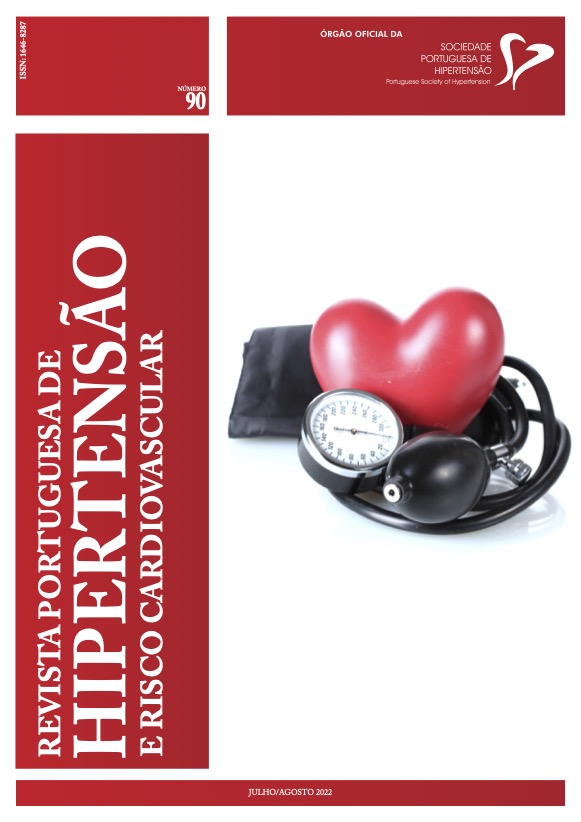EXPLORATORY ANALYSIS OF CARDIOVASCULAR RISK FACTORS ASSOCIATION IN PRIMARY CARE PATIENTS WITH OR WITHOUT CEREBROVASCULAR EVENTS
DOI:
https://doi.org/10.58043/rphrc.48Abstract
Introduction: Cerebrovascular diseases (CerVD) are the first and second cause of dead among women and men, respectively, in industrialized countries. The main cardiovascular risk factor (CVRF) is hypertension. This information is provided by large international cohorts, however, local reality can be different and remains uncharacterized. We seek to clarify the association of CVRF and CerVD coding in a primary care setting, to tune the risk perception of professionals and its transmission to the patients.
Methods: observational retrospective study with exploratory data analysis, in an anonymized convenience sample of a primary care setting, with 18 years or above and at least one arterial systolic pressure (ASP) evaluation registered before 31/12/2018. We considered CerVD the ICPC-2 coding in MIMUF until the mentioned date, with K89 – transient cerebral ischemia, K90 – thrombosis/stroke and K91 – cerebrovascular disease. We characterized the registered CVRF (age, ASP, arterial diastolic pressure (ADP), total cholesterol (TC), high density lipoprotein cholesterol (HDL), triglycerides, obesity, smoking, dyslipidemia and diabetes) through histograms for the continuous variables and cardinality diagrams of CVRF combinations partitioned boxplots, produced in R 3.4.2 software. For the multivariate analysis of CerVD case associations according to the combination of CVRF, we created a logistic regression model with the major CVRF.
Results: We included 8.769 individuals for analysis, mean age 53,43 years, mainly females (58,5%), of whom 278 with CerVd. The sample included 41,8% individuals with dyslipidemia, 35,0% with hypertension, 21,5% with obesity, 18,4% smokers and 12,6% diabetics. The most frequent CVRF was the combination of hypertension + dyslipidemia, followed by isolated smoking and dyslipidemia. We observed a prevalence of 3,2% for CerVD, including 2,0% for stroke. Hypertension, diabetes and dyslipidemia prevalence was higher in the presence of CerVD, while obesity and smoking prevalence was lower. Systolic and diastolic pressure were higher in males and those with CerVD, whose majority had a systolic pressure above 140 mmHg (54%). Coding of CerVD had a later in life peak in women (80-90 years) compared to men (70-80 years). The logistic regression model did not retrieve any significant differences between the predicted and observed results (Hosmer-Lemeshow, chi-square=6.5781; df=8; p=0.5828) and included the following predictors: age, female gender, smoking, diabetes, hypertension, dyslipidemia and obesity. According to our model the odds of a given case to be coded for CerVD is: 1/[1+exp(-z)], where z = -7.00757 - 0.08618(female gender) + 0.04785(age) + 0.22364(smoking) - 0.35407 (diabetes) + 0.88350(hypertension) + 0.38920(dyslipidemia) -0.23875(obesity) and exp(x) is the natural exponential of x. Based on this model the odds ratio did not include the unit for the predictors age, dyslipidemia and hypertension, for which we can affirm the association.
Discussion: The results are in line with the raw prevalence of estimated stroke in Portugal. Also, CVRF distribution in congruent with international descriptions. It is relevant that 54% of the patients coded with CerVD present with systolic pressure above 140 mmHg, probably representing a sub-optimal control of this CVRF after event. The regression model is valid to our sample, and showed that age (p<0,00001), hypertension (p<0,001) and dyslipidemia (p<0,05) are associated with CerVd coding in a primary care center. The conclusions are limited to our sample, given it is an observational, exploratory and unicentric study, subjected to problem coding by the clinicians.
Downloads
References
- Nichols M, Townsend N, Luengo-Fernandez R, Leal J, Gray A, Scarborough P, et al (2012). European Cardiovascular Disease Statistics 2012. European Heart Network, Brussels, European Society of Cardiology, Sophia Antipolis
- Kalaria RN.Cerebrovascular disease and mechanisms of cognitive impairment: evidence from clinicopathological studies in humans. Stroke. 2012;43:2526–2534.
- OECD/European Union (2014), Health at a Glance: Europe 2014, OECD Publishing, Paris, https://doi. org/10.1787/health_glance_eur-2014-en.
– DGS. (2016) Doenças Cérebro-Cardiovasculares em Números – 2015. Direção-Geral da Saúde: Lisboa 5 - Ramalheira CR, Gonçalves AM, Gomes F, Dutschmann R, Gusmão R. Tendências seculares na mortalidade por doenças cerebrovasculares em Portugal: 1902-2012. Med Interna. 2020;27(2):139-44
- Arboix A. Cardiovascular risk factors for acute stroke: Risk profiles in the different subtypes of ischemic stroke. World J Clin Cases. 2015;3(5):418
- Tu JV. Reducing the global burden of stroke: INTERSTROKE. Lancet. 2010;376:74-5
Lewington S, Clarke R, Qizilbash N, et al. Age-specific relevance of usual blood pressure to vascular mortality: a meta-analysis of individual data for one million adults in 61 prospective studies. Lancet. 2002;360(9349):1903- 13
- Silva PM, Lima MJ, Neves PM, Macedo ME. Prevalência de fatores de risco cardiovascular e outras comorbilidades em doentes com hipertensão arterial assistidos nos Cuidados de Saúde Primários: estudo PRECISE. Rev Port Cardiol. 2019; 38(6):427-37
- Polonia J, Martins L, Pinto F, Nazare J. Prevalence, awareness, treatment and control of hypertension and salt intake in Portugal: changes over a decade. The PHYSA study. J Hyperten. 2014;32:1211-21
- Fiuza M, Cortez-Dias N, Martins S, Belo A; VALSIM study investigators. Metabolic syndrome in Portugal: prevalence and implications for cardiovascular risk - results from the VALSIM Study. Rev Port Cardiol. 2008 Dec;27(12):1495-529.
- Sousa-Uva M, Dias CM (2014). Prevalência de Acidente Vascular Cerebral na população portuguesa: dados da amostra ECOS 2013. INSA. 9:12-4
– Cortez-Dias N, Martins SR, Belo A, Fiúza M. Caracterização do perfil lipídico nos utentes dos cuidados de saúde primários em Portugal. Rev Port Cardiol. 2013;32(12):987-96
– Conroy RM, Pyörälä K, Fitzgerald AP, Sans S, Menotti A, De Backer G, et al. Estimation of ten-year risk of fatal cardiovascular disease in Europe: the SCORE project. European Heart Journal. 2003;24(11):987–1003 14 - Pencina MJ, D’Agostino RB Sr, Larson MG, Massaro JM, Vasan RS. Predicting the 30-year risk of cardiovascular disease: the framingham heart study. Circulation. 2009 Jun 23;119(24):3078-84.
- Lewington S, Clarke R, Qizilbash N, Peto R, Collins R. Age-specific relevance of usual blood pressure to vascular mortality: a meta-analysis of individual data for one million adults in 61 prospective studies. Lancet. 2002; 360(9349):1903-13
Downloads
Published
How to Cite
Issue
Section
License
Copyright (c) 2023 André Gomes Roque, Lara Cabrita, Ana João Taveira, Pedro Damião, Eliana Bonifácio

This work is licensed under a Creative Commons Attribution 4.0 International License.




